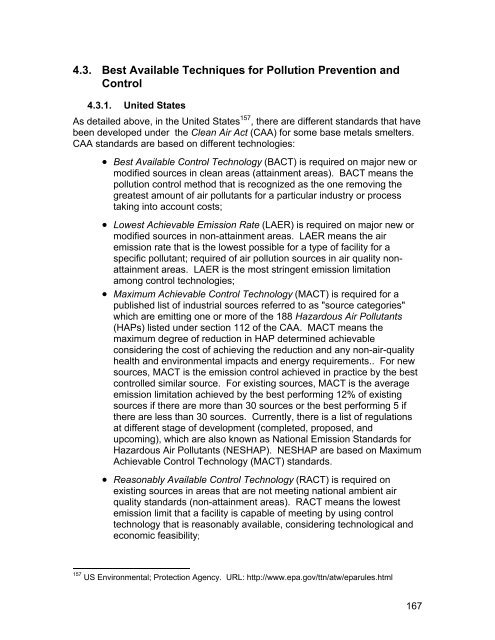(MERAF) for the Base Metals Smelting Sector - CCME
(MERAF) for the Base Metals Smelting Sector - CCME
(MERAF) for the Base Metals Smelting Sector - CCME
Create successful ePaper yourself
Turn your PDF publications into a flip-book with our unique Google optimized e-Paper software.
4.3. Best Available Techniques <strong>for</strong> Pollution Prevention and<br />
Control<br />
4.3.1. United States<br />
As detailed above, in <strong>the</strong> United States 157 , <strong>the</strong>re are different standards that have<br />
been developed under <strong>the</strong> Clean Air Act (CAA) <strong>for</strong> some base metals smelters.<br />
CAA standards are based on different technologies:<br />
• Best Available Control Technology (BACT) is required on major new or<br />
modified sources in clean areas (attainment areas). BACT means <strong>the</strong><br />
pollution control method that is recognized as <strong>the</strong> one removing <strong>the</strong><br />
greatest amount of air pollutants <strong>for</strong> a particular industry or process<br />
taking into account costs;<br />
• Lowest Achievable Emission Rate (LAER) is required on major new or<br />
modified sources in non-attainment areas. LAER means <strong>the</strong> air<br />
emission rate that is <strong>the</strong> lowest possible <strong>for</strong> a type of facility <strong>for</strong> a<br />
specific pollutant; required of air pollution sources in air quality nonattainment<br />
areas. LAER is <strong>the</strong> most stringent emission limitation<br />
among control technologies;<br />
• Maximum Achievable Control Technology (MACT) is required <strong>for</strong> a<br />
published list of industrial sources referred to as "source categories"<br />
which are emitting one or more of <strong>the</strong> 188 Hazardous Air Pollutants<br />
(HAPs) listed under section 112 of <strong>the</strong> CAA. MACT means <strong>the</strong><br />
maximum degree of reduction in HAP determined achievable<br />
considering <strong>the</strong> cost of achieving <strong>the</strong> reduction and any non-air-quality<br />
health and environmental impacts and energy requirements.. For new<br />
sources, MACT is <strong>the</strong> emission control achieved in practice by <strong>the</strong> best<br />
controlled similar source. For existing sources, MACT is <strong>the</strong> average<br />
emission limitation achieved by <strong>the</strong> best per<strong>for</strong>ming 12% of existing<br />
sources if <strong>the</strong>re are more than 30 sources or <strong>the</strong> best per<strong>for</strong>ming 5 if<br />
<strong>the</strong>re are less than 30 sources. Currently, <strong>the</strong>re is a list of regulations<br />
at different stage of development (completed, proposed, and<br />
upcoming), which are also known as National Emission Standards <strong>for</strong><br />
Hazardous Air Pollutants (NESHAP). NESHAP are based on Maximum<br />
Achievable Control Technology (MACT) standards.<br />
• Reasonably Available Control Technology (RACT) is required on<br />
existing sources in areas that are not meeting national ambient air<br />
quality standards (non-attainment areas). RACT means <strong>the</strong> lowest<br />
emission limit that a facility is capable of meeting by using control<br />
technology that is reasonably available, considering technological and<br />
economic feasibility;<br />
157 US Environmental; Protection Agency. URL: http://www.epa.gov/ttn/atw/eparules.html<br />
167
















